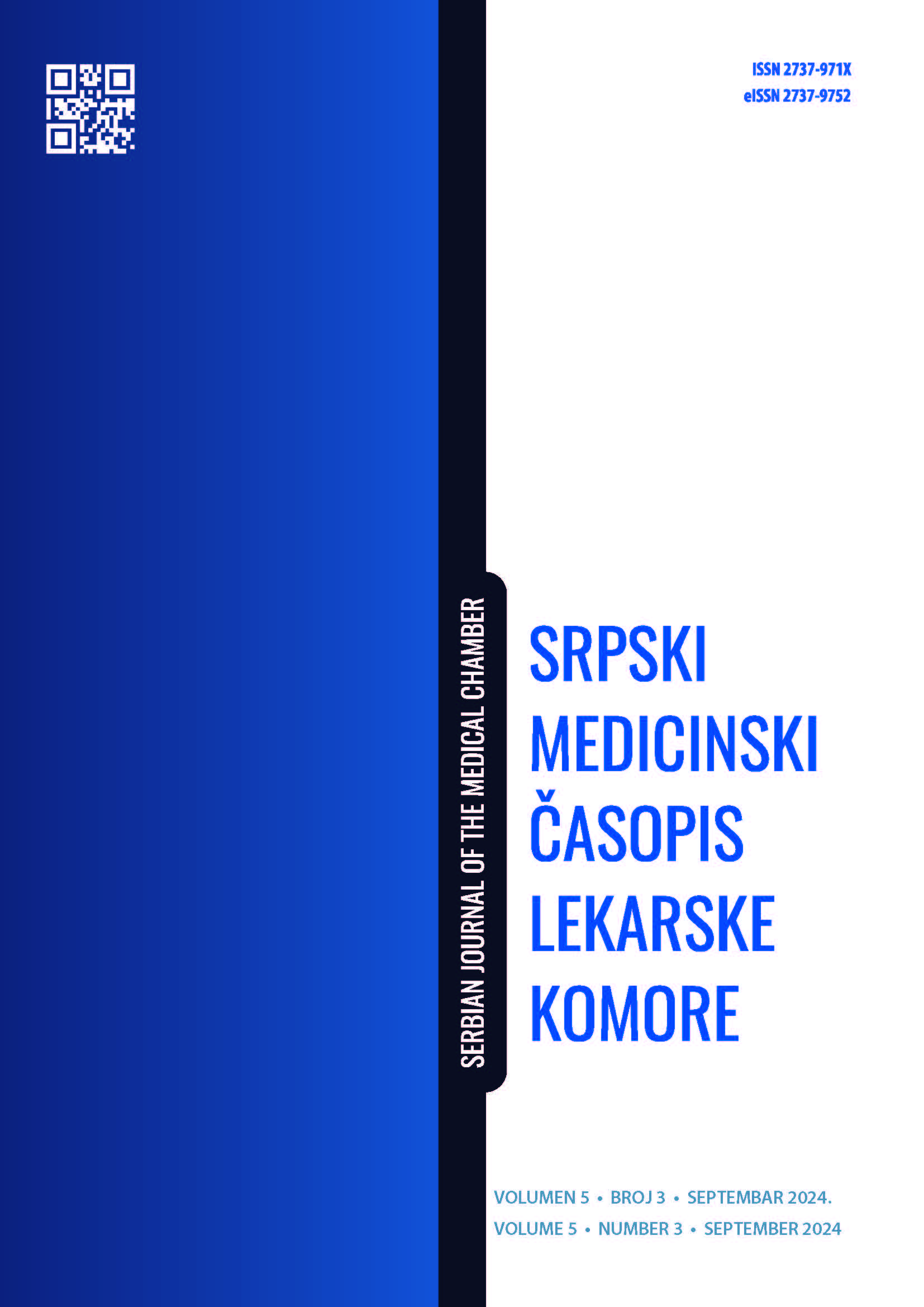DRUG-INDUCED THROMBOCYTOPENIA
Abstract
Drugs could cause thrombocytopenia, mostly in hospitalized patients. The incidence of this adverse reaction to medicines is around 10/1,000,000 inhabitants/year. Depending on the pathophysiological mechanism, drug-induced thrombocytopenia can be classified into immune and non-immune. Drugs such as cytostatics, linezolid, ganciclovir, valacyclovir, aspirin, and vancomycin can induce a non-immune form of thrombocytopenia. They achieve this by exerting direct cytotoxic effects on megakaryocytes and platelets, or through proapoptotic mechanisms that affect platelets. On the other hand, the immune form is caused by drug-specific antibodies, which, in the presence of the drug or its metabolite, bind to platelet antigens, leading to accelerated destruction of platelets. Apart from this classic form of drug-induced immune thrombocytopenia (DITP), which is characterized by the acute onset of severe thrombocytopenia (nadir platelet counts < 20 x 109/L) and bleeding, special forms such as heparin-induced thrombocytopenia (HIT), thrombocytopenia caused by the use of immune checkpoint inhibitors, and vaccine-induced thrombotic thrombocytopenia (VITT) are identified. HIT is the most common DITP in which nadir platelet count is usually around 60x109/L and the clinical presentation is dominated by thrombosis (venous and less often arterial). Conversely, VITT is characterized by the onset of thrombosis and thrombocytopenia between 4 and 30 days after the administration of adenoviral vector vaccines. The mortality in this form of LITP ranges between 25% and 60%.
References
Bakchoul T, Marini I. Drug-associated thrombocytopenia. Hematology Am Soc Hematol Educ Program. 2018;2018(1):576-83. doi: 10.1182/asheducation-2018.1.576.
Priziola JL, Smythe MA, Dager WE. Drug-induced thrombocytopenia in critically ill patients. Crit Care Med. 2010;38(6 Suppl):S145-54. doi: 10.1097/CCM.0b013e3181de0b88.
Marini I, Uzun G, Jamal K, Bakchoul T. Treatment of drug-induced immune thrombocytopenias. Haematologica. 2022;107(6):1264-77 doi: 10.3324/haematol.2021.279484.
Arnold DM, Cuker A. Drug-induced immune thrombocytopenia. UpToDate. Waltham: UpToDate Inc. 2023. [Cited 2024 June 26].
Suvajdžić-Vuković N. Trombocitopenija i trombocitoza. U: Konsultativna hematologija. Antić D, Krstovski N, urednici. Beograd: Medicinski fakultet Univerziteta u Beogradu; 2023. str. 26-39.
Gerson SL, Kaplan SL, Bruss JB, Le V, Arellano FM, Hafkin B, et al. Hematologic effects of linezolid: summary of clinical experience. Antimicrob Agents Chemother. 2002;46(8):2723-6. doi: 10.1128/AAC.46.8.2723-2726.2002.
Curtis BR, Kaliszewski J, Marques MB, Saif MW, Nabelle L, Blank J, et al. Immune-mediated thrombocytopenia resulting from sensitivity to oxaliplatin. Am J Hematol. 2006;81(3):193-8. doi: 10.1002/ajh.20516.
Mirtsching BC, George JN, Aster RH, Curtis BR. Irinotecan-induced immune thrombocytopenia. Am J Med Sci. 2014;347(2):167-9. doi: 10.1097/MAJ.0000000000000243.
Cvetković Z, Suvajdžić-Vuković N, Todorović Z, Panić M, Nešković A. Simvastatin and amlodipine induced thrombocytopenia in the same patient: double trouble and a literature review. J Clin Pharm Ther. 2013;38(3):246-8. doi: 10.1111/jcpt.12051.
Royer DJ, George JN, Terrell DR. Thrombocytopenia as an adverse effect of complementary and alternative medicines, herbal remedies, nutritional supplements, foods, and beverages. Eur J Haematol. 2010;84(5):421-9 doi: 10.1111/j.1600-0609.2010.01415.x.
Cuker A, Coles AJ, Sullivan H, Fox E, Goldberg M, Oyuela P, et al. A distinctive form of immune thrombocytopenia in a phase 2 study of alemtuzumab for the treatment of relapsing-remitting multiple sclerosis. Blood. 2011;118(24):6299-305. doi: 10.1182/blood-2011-08-371138.
Korać B, Juranec S, Delalić Đ, Prkačin I. Drug – induced immune thrombocytopenia - a case report. Med Jad. 2024;54:53–7. doi:10.57140/mj.54.1.8.
Cisarovsky C, Théaudin M, Bart PA, Stalder G, Alberio L. Severe Late-Onset Drug-Induced immune thrombocytopenia following IFN β-1a treatment: a case report of a 52-year-old woman with relapse-remitting multiple sclerosis. Case Rep Hematol. 2022;2022:2767031. doi: 10.1155/2022/2767031.
Moore DC, Elmes JB, Arnall JR, Strassel SA, Patel JN. PD-1/PD-L1 inhibitor-induced immune thrombocytopenia: A pharmacovigilance study and systematic review. Int Immunopharmacol. 2024;129:111606. doi: 10.1016/j.intimp.2024.
George JN, Raskob GE, Shah SR, Rizvi MA, Hamilton SA, Osborne S, et al. Drug-induced thrombocytopenia: a systematic review of published case reports. Ann Intern Med. 1998;129(11):886-90. doi: 10.7326/0003-4819-129-11_part_1-199812010-00009.
Crowther M, Pishko A. Management of heparin-induced thrombocytopenia. In: UpToDate. Leung LLK, editor. Wolters Kluwer. [Cited 2024 June 28].
Schneider BJ, Naidoo J, Santomasso BD, Lacchetti C, Adkins S, Anadkat M, et al. Management of immune-related adverse events in patients treated with immune checkpoint inhibitor therapy: ASCO Guideline Update. J Clin Oncol. 2021;39(36):4073-4126. doi: 10.1200/JCO.21.01440.
Brahmer JR, Lacchetti C, Schneider BJ, Atkins MB, Brassil KJ, Caterino JM, et al. Management of immune-related adverse events in patients treated with immune checkpoint inhibitor therapy: American society of clinical oncology clinical practice guideline. J Clin Oncol. 2018;36(17):1714-68. doi: 10.1200/JCO.2017.77.6385
Arachchillage DJ, Thachil J, Anderson JAM, Baker P, Poles A, Kitchen S, et al. Diagnosis and management of heparin-induced thrombocytopenia: Third edition. Br J Haematol. 2024;204(2):459–475. https://doi.org/10.1111/bjh.19180
Mitrović M, Pantić N. Thrombocytopenia and COVID-19: Differential diagnosis and therapy. Serbian Journal of the Medical Chamber. 2022;3(1):87-99. doi: 10.5937/smclk3-35382
Faghihi H, Mottaghi-Dastjerdi N, Sharifzadeh M, Rahimi Kakavandi N. ChAdOx1 nCoV-19 vaccine and thrombosis with thrombocytopenia syndrome among adults: A systematic review. Adv Pharm Bull. 2023;13(4):723-35. doi: 10.34172/apb.2023.081
Zidan A, Noureldin A, Kumar SA, Elsebaie A, Othman M. COVID-19 vaccine-associated immune thrombosis and thrombocytopenia (VITT): Diagnostic discrepancies and global implications. Semin Thromb Hemost. 2023;49(1):9-14. doi: 10.1055/s-0042-1759684.
Lotti E, Gori AM, Berteotti M, Rogolino A, Cesari F, Poli D, et al. Natural history of anti-PF4 antibodies in patients with vaccine-induced immune thrombocytopenia and thrombosis. Blood Transfus. 2024;22(3):246-252. doi: 10.2450/BloodTransfus.
Elberry MH, Abdelgawad HAH, Hamdallah A, Abdella WS, Ahmed AS, Ghaith HS, et al. A systematic review of vaccine-induced thrombotic thrombocytopenia in individuals who received COVID-19 adenoviral-vector-based vaccines. J Thromb Thrombolysis. 2022;53(4):798-823. doi: 10.1007/s11239-021-02626-w.
Cvetković M, Pantić N, Virijević M, Pravdić Z, Sabljić N, Mitrović M, et al. Relapse of Evans syndrome following BNT162b2 (Pfizer-BioNTech) COVID-19 vaccine: case report and literature review. J Infect Dev Ctries. 2023;17(6):800-4. doi: 10.3855/jidc.17719.

